It is common knowledge that dogs wag their tails when they’re happy, but many people are unaware that cats do as well. “Do cats wag their tails?” you might wonder.
Yes, they wag their tails in the same way that dogs do, but these rambunctious felines do so for totally different reasons. When cats are feeling a certain way, they move their tails in various ways, from subtle shimmies to full wags.
So, what does it mean when a cat wags its tail?
Cats wag their tail while purring because they want to indicate that they are having fun with something. When cats are irritated or annoyed, they always wag their tails, but this is not always the case.
High praise comes in the form of purring and twitching of the tail. She’s telling you that she needs you to keep going.
Cat tail language is very advanced, and it can be a good indicator of your cat’s mood. You can normally tell how your cat is feeling by paying attention to the direction and speed of their wagging tail, as well as the rest of their body.
Check out our list of potential reasons why your cat is wagging its tail.
Key Takeaways
- Cats wag their tail while purring to indicate that they are having fun.
- Possible reasons for a cat wagging their tail include being scared, annoyed, or playing.
- It is important to pay attention to a cat’s body language to understand their mood and needs.
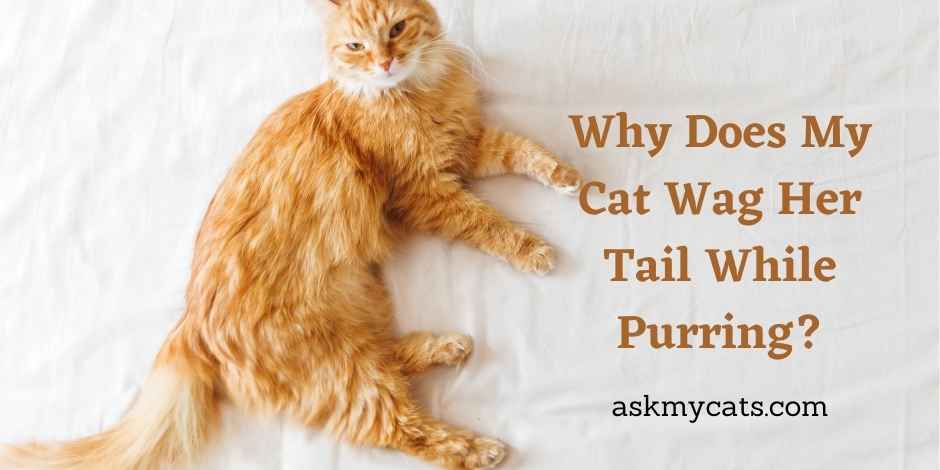

Give Your Cat the Perfect Day
Get the Free Ebook!
What Causes Cats To Wag Their Tails While Purring?
Cats, unlike dogs, usually wag their tails whenever annoyed or irritated, but this isn’t always the reality. Cat tail language is very advanced, and it can be a good indicator of your cat’s mood.
You can normally tell how your cat is feeling by paying attention to the direction and speed of its wagging tail, as well as the rest of its body.
Check out our list of potential reasons why your cat is wagging its tail.
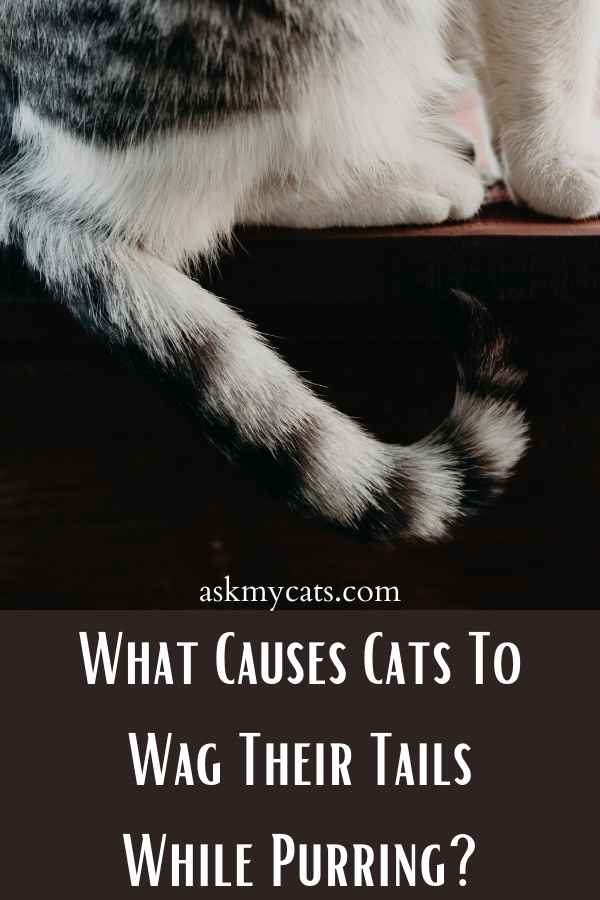
1. Low-key Flick
A fast back-and-forth action will be shown for the low flick tail wagging.
If you see your cat’s tail swishing, give them some space because that means they’re frustrated and want to be alone.
This cat tail language is most likely to be seen when they are placed in an unpleasant situation, such as going to the veterinarian.
2. Wagging At A Low Level
If your cat’s wagging tail isn’t wagging much, it’s a sign that they’re frightened.
Their ears may also be pinned back, their body hunched low to the ground, and their tail tucked between their legs if they’re really terrified.
3. Swish Slowly
When their tail swishes slowly from left to right, it indicates that they are slightly angry.
If you see this, give your cat some space because it may soon transform into an angry low flick.
4. Swish Quickly
This cat tail swishing is often mistaken for the angry low flick, but it couldn’t be further from the truth. When your cat is playful, he will swish quickly from side to side, often followed by a pounce.
When playing with toys or another cat, this behavior is usually accompanied by dilated pupils and forward-pointing ears.
5. Twitch Quickly
If you notice your cat’s tail twitch quickly, it typically means he or she is focused.
When they’re window-watching a tiny critter or bird, you’ll most likely notice this cat tail language, as well as bizarre cat noises like chirping or chattering.
6. The Treble Clef
The tail quiver is the cutest tail action because it indicates that they’re thrilled to see you! Your cat will approach you with its tail high in the air, quivering slightly like a rattlesnake.
They purr, rub their faces on you, and sometimes meow happily as a way of signaling to you or other cats that they are ready for interaction.
7. Tail Securing
Your cat may sometimes wrap its tail around your hand, shoulder, or even neck to show you affection.
However, most cats prefer to express their affection for you by giving you head butts.
Also, check out why does my cat wrap her tail around me
8. Tail Fluffed Up
When your cat’s tail becomes extremely fluffed up, it indicates that they are in danger. They usually do this when they’re in a fight, whether it’s with another dog, cat, or even your super scary hoover.
They fluff up to make themselves appear stronger and scarier to their opponent, according to The Nest, which is why they’ll also arch their back.
9. Twitch In Your Sleep
When you pet or talk to your cat while they are sleeping, it may twitch its tail. “I know you’re there, but I feel safe enough to keep snoozing anyway,” they say with this cat tail language.
10. Lying Down Wave
It’s been proposed that wagging cat tails will signify that they’re in pain or unwell. Your cat may be feeling under the weather if they’re lying down and waving its tail while also acting strangely – such as refusing to eat or spending a lot of time in hiding.
If you’re worried about your cat’s health, schedule an appointment with a veterinarian as soon as possible.
You now have a complete understanding of why cats wag their tails! Remember to pay attention to your cat’s tail language the next time you go in for a cuddle – it’ll save you from any unexpected whacks or nips!
Also, check out why does my cat hit me with her tail
What Does It Mean When Your Cat Purrs and Wags Its Tail?
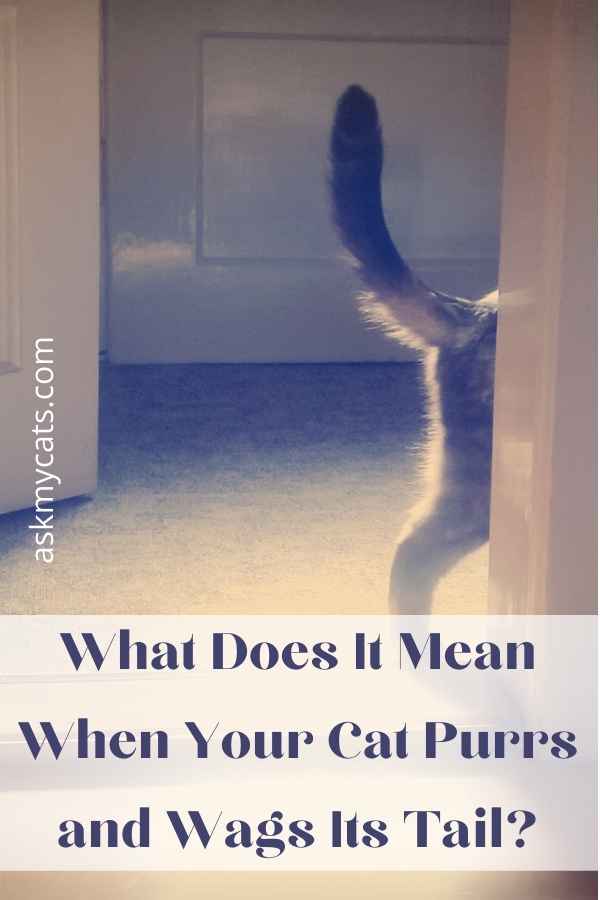
The response varies depending on the cat, what’s going on in their surroundings, and how they’re wagging their tail.
A happy or excited cat, for example, would flick the end of its tail. When a dog’s tail wags rapidly, it usually means they’re angry.
Cats communicate in a variety of complex ways that even scientists studying them and people who have spent their entire lives with cats don’t fully comprehend.
We can only make educated guesses as to what our furry friends are going to say in many situations.
To make the best-educated guess, you must spend time getting to know your cat and paying attention to environmental factors.
However, learning about cat behavior is an important part of making an educated guess.
This is why I’m going to tell you all of the reasons your cat would wag its tail or purr, so you can better connect the dots and figure out how your cat is feeling.
Although some people think that purring always means a cat is content and that a wagging tail always means a cat is irritated, this is not always the case.
The most important thing to watch is how your cat wags its tail—this will often give you your best answer.
Must Read: Cat Purring Effect On Humans: The Power of Cat Purring
Can Purring And Wagging Express Multiple Emotions?
A cheerful cat isn’t always a purring cat. Although that myth exists for a reason—purring cats are often happy—important it’s to recognize that it isn’t always true.
Purring may be for a variety of reasons. This is what your cat will be:
- Happy, at ease, and at a convenience
- If you’re looking for food or attention, you’ve come to the right place.
- They’re scared and want to calm down.
- In pain and attempting self-healing
- She’s guiding her newborn kittens, who aren’t yet able to hear.
Purring starts when a cat is only a few days old and lasts for the rest of their lives. It serves as a means of communication as well as a means of keeping their muscles toned and even aiding in the healing of some injuries.
It’s possible that this is why cats have “nine lives” and sustain fewer injuries after a long fall than other animals. After surgery, cats have fewer complications than dogs, and purring may be one of the reasons for this.
Purring isn’t just for housecats; it’s also found in some large cat species, indicating that this unusual cat sound evolved a long time ago and has served cats throughout history.
Now that we’ve covered why cats purr, let’s talk about tail wagging and what it means when the two behaviors coexist.
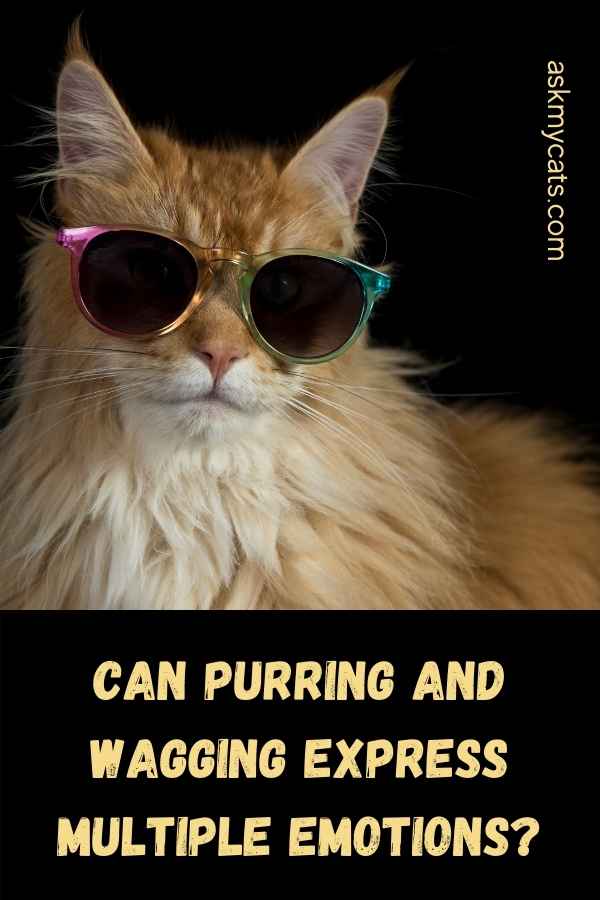
1. Excited And Cheerful
Cats who only flick the end of their tail are usually excited or cheerful. Petting their cats, walking in the door, or opening a can of tasty cat food are all examples of this behavior.
One of my cats doesn’t like to be petted very much, but when he does come to sit next to me, he’ll flick the end of his tail to demonstrate he’s pleased to be receiving attention. At this moment, he’ll also purr.
If your cat purrs and flicks its tail in this manner, it’s safe to assume they’re pleased or excited about what’s about to happen, depending on its surroundings.
“Cats wag their tails for a variety of reasons, including to communicate with their owners and other cats, to maintain their balance while climbing or jumping, and to express their playfulness or energy.
When a cat is wagging its tail while purring, it is likely expressing positive emotions and seeking attention or affection from its owner.”
Dr. Elizabeth Colleran, DVM, President of the International Society of Feline Medicine
2. Annoyed Angry Kitty
You’ve also seen your cat wag their whole tail when they’re about to pounce on a laser light or toy if you play with them.
It usually begins as a slow wag and picks up speed as they become more excited.
In that case, your cat is ecstatic and having a good time! Cats, on the other hand, wag their tails in this manner when they are irritated or enraged.
Cats will purr when they are anxious or scared, as we previously discussed. If your cat’s tail is wagging rapidly and you aren’t playing with them, I recommend backing off and giving them some space.
Even if the cat purrs, don’t mistake this for mixed signals—your cat is expressing their true feelings, and if you don’t pay attention to their body language, you’ll get bitten or scratched.
If you need to do something important during this period, such as grooming, you should take a step back and patiently train your cat.
Maybe your cat can only tolerate being combed for a few minutes, and you’ll have to work with that until you gain their confidence and can extend grooming sessions.
Alternatively, you would want to check that you aren’t snagging their fur while brushing.
Cats, like dogs, should be bred to be good citizens. When your pet behaves well, lavish praise and treats on them, and back off when they become irritated with you.
Always try to end on a positive note—don’t wait until they bite before scolding them, as this negative reinforcement will only make them pickier the next time.
“Cats may also wag their tails when they are feeling anxious or stressed, as a way of self-soothing and calming themselves down.
If your cat is wagging its tail while purring and you are not sure why, consider taking a moment to observe the cat’s body language and behavior, as well as the context in which the tail-wagging is occurring, to identify the source of its stress or anxiety.”
Dr. John Ciribassi, DVM, Diplomate of the American Board of Veterinary Practitioners
Interesting Read: Why Does My Cat Lay On Me And Purr?
3. Kind Affectionate Kitty
Have you ever had a cat “pet” you with its tail? Many of my friends do this, and it’s cute!
Fortunately, it’s intended to be affectionate. We are not misinterpreting their intentions in any way. If your cat is rubbing their tail against you, it is because they are bonding with you.
They may also be trying to get your attention so that you can pet or feed them, and rubbing you with their tail is a gentle reminder that they are present and in need.
Cats also have scent markers in their tails, and they enjoy sharing their smell with you and marking you as a family member. It’s akin to when a kitten rubs their cheek against yours.
Cats do this because it comes naturally to them. When they live in colonies, they will rub against each other and exchange scents. This is a method for them to tell who is a member of the colony and who is an outsider.
This also explains why cats do strange things like going to the veterinarian, returning smelling different, and being avoided or even assaulted by other cats in the house.
Interesting Read: Why Does My Cat Drool When He Purrs?
Why Does A Cat Wag And Purr At The Same Time?
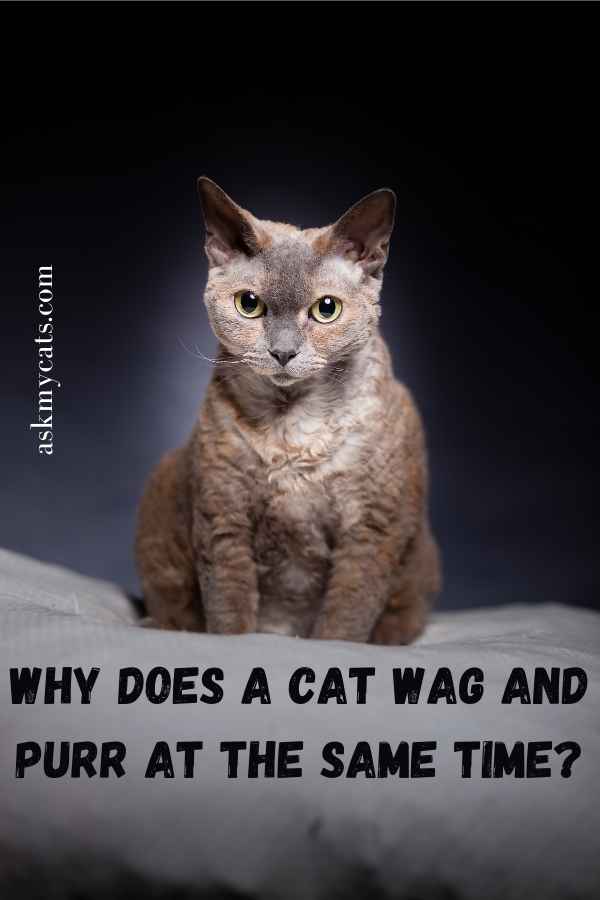
Purring is often interpreted as a sign of a cat’s happiness, and this is one of the reasons a cat purrs. They will also purr if they are in pain or are worried about something.
When it was time for dinner, my cat would break out in a desperate purr.
It will take some time to learn how to tell the difference, but when cats are in pain, their purrs are always louder and quicker than when they are happy and satisfied.
There is another side to tail wagging, just as there is another side to purring. Some cats, almost like dogs, wag their tails when they are pleased.
I wouldn’t believe it if I hadn’t had one of these cats, but it’s true: some cats wag their tails to express love.
Purrs and tail wags are likely signs that your cat is content if she is behaving affectionately and appears relaxed.
Although an enraged cat may skip the tail switching and go straight to the swishing, the aggressive tail wag frequently begins with a twitching at the end and builds up to an agitated swishing.
Depending on your cat and the circumstances, you can swish slowly or quickly.
Pay close attention to your girl’s body language. It’s a sign that she’s uneasy if her muscles tense up and her eyes dilate.
Interesting Read: Why Does My Cat Purr And Bite Me?
How To Respond When Your Cat Wag Their Tails While Purring
1. Pet or cuddle your cat
If your cat is wagging their tail and purring, it may be a sign that they want to be petted or cuddled. Take a moment to give your cat some love and affection, and see if their tail-wagging and purring continue or intensify.
2. Check for any signs of distress or discomfort
While cats may wag their tails and purr when they are happy and content, they may also do so when they are anxious, stressed, or in pain.
If your cat is wagging their tail and purring and you are not sure why, take a moment to check for any signs of distress or discomfort, such as panting, meowing, or scratching.
If you suspect that your cat is in pain or discomfort, consider taking them to the vet for a check-up.
3. Provide food and water
Cats may wag their tails and purr when they are hungry or thirsty.
If your cat is wagging their tail and purring and you have not recently fed or watered them, consider providing some food and water to see if this satisfies their needs.
4. Play with your cat
Cats may wag their tails and purr when they are feeling playful or energetic.
If your cat is wagging their tail and purring and you have not recently played with them, consider engaging in some interactive playtime to see if this satisfies their needs.
5. Seek professional help if necessary
If you are not sure why your cat is wagging their tail and purring, or if you are concerned about your cat’s behavior, consider seeking professional help from a veterinarian or a cat behaviorist.
They will be able to assess your cat’s overall health and well-being and provide guidance on how to address any concerns you may have.
Some of the Interesting reads regarding cat purring:
- Why Do Cats Purr? The Science of Cat Purring
- Why Doesn’t My Cat Purr?
- How To Make A Cat Purr?
- Why Do Cats Purr When They Are Dying?
- Do Cats Purr When They Sleep?
- Why Does My Cat Purr When He Sees Me?
- Why Is My Cat Purring So Much?
- Why Does My Cat Purr So Loudly?
- Why Do Cats Purr When You Stroke Them?
- Differences In Purring Between Cat Breeds
- Why Does My Cat’s Purring Sound Congested?
- Can Cats Control Their Purring?
- Do Cats Purr When They Are Happy?
- Do Cats Breathe Faster When Purring?
- How To Purr Like A Cat?
- Why Do Cat’s Noses Get Wet When They Purr?
- Why Is My Pregnant Cat Purring So Much?
- Why Do Cats Purr And Knead?
- Do Cats Purr When They Are Sick Or In Pain?
- Do Feral Cats Purr?
Frequently Asked Questions
Do cats wag their tails when happy?
It’s a common misconception that cats wag their tails only when they’re mad, but there are a variety of reasons why they would do so. Contrary to popular belief, a cat’s tail is extremely expressive and can reveal whether they are playful, happy, or fearful.
Why does my cat’s tail vibrate when I pet her?
The quivering of a cat’s tail may indicate slight frustration. If the cat’s tail stands up straight and the entire length appears to be quivering with excitement, it means just that: excitement. Based on the activity he is currently engaged in, you will be able to tell which emotion he is showing.
What does it mean when a cat flicks its tail while lying down?
Irritation and/or enthusiasm are indicated by thrashing (or whipping) tail motions. A thrashing tail is normally followed by a “thumping” sound as the kitty’s tail hits the floor while lying down. She’s (subconsciously) telling you that your current petting session is going out of hand.
Final Words
It’s not always straightforward or intuitive to decipher what our animals are trying to tell us through their body language. Cats aren’t any different.
Often, the habits that dogs associate with friendliness are actually signs of stress or anxiety in cats. Misinterpreting your cat’s body language can result in bites, scratches, or worse, so it’s critical to understand what she’s saying.
There is a lot of common feline behavior that is easy to misinterpret, ranging from a tail wagging to purring.
Let us know in the comments section below if your cat is frequently tail-wagging or purring constantly!
